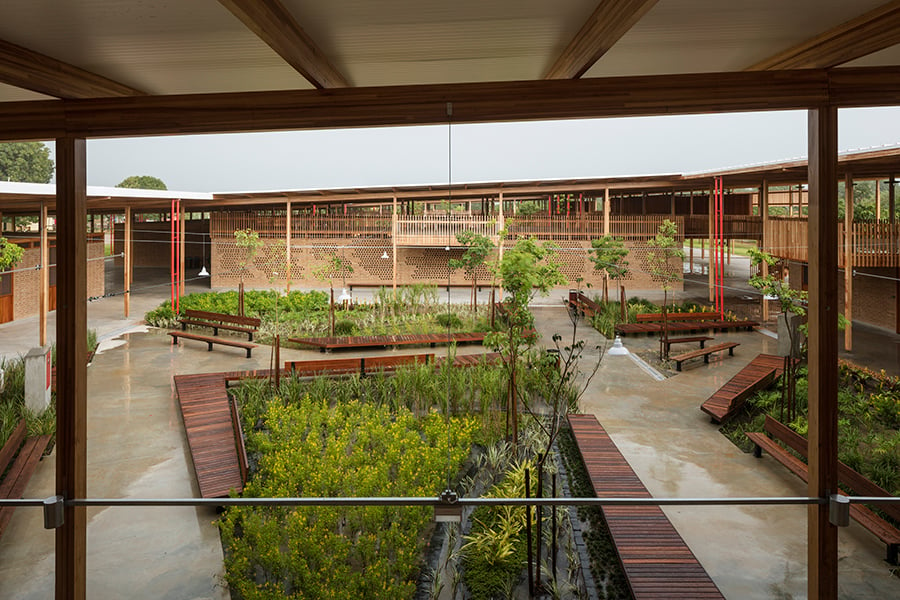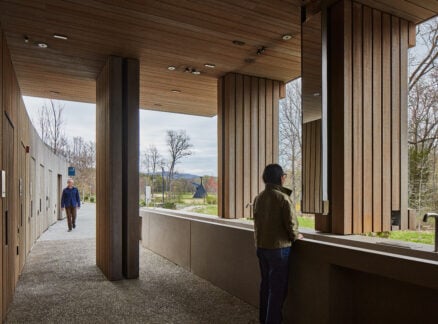
November 26, 2018
School in Remote Corner of Brazil Wins the 2018 RIBA International Prize
The 270,000-square-foot Children’s Village, designed by São Paulo–based firms Aleph Zero and Rosenbaum, was selected by a panel that included Elizabeth Diller and Kazuyo Sejima.

The world’s most architecturally and socially significant building of 2018—according to the London-based Royal Institute of British Architects (RIBA)—sits on the edge of the Amazon rainforest in a remote rural corner of Northern Brazil. Children’s Village, a 270,000-square-foot boarding school for 540 students, has been awarded the second edition of the prestigious biennial RIBA International Prize, which recognizes the most inspirational and significant new buildings across the globe.
The jury panel, led by Elizabeth Diller of Diller Scofidio + Renfro, traveled around the world to visit the prize’s four shortlisted projects. According to jury member Joshua Bolchover of Hong Kong–based studio Rural Urban Framework, the panel was looking for “great spaces, interesting dynamics, what the story was and how the architects responded to that, and how the architects were able to innovate within their political and physical frame.” With Children’s Village, they found a project that adeptly responded to its challenging topography, tropical climate, and local community.

Designed by Gustavo Utrabo and Petro Duschenes of São Paulo–based firm Aleph Zero (the youngest practice in the short-listed group) and Marcelo Rosenbaum and Adriana Benguela of Rosenbaum (a firm also based in São Paulo), the school’s creation was rooted in an extensive co-design and research process that aimed to make the school’s pupils—many of whom are the children of local farmers—feel more at home at Children’s Village. “The most important thing for us was to help increase the children’s sense of belonging,” says Utrabo. Aleph Zero and Rosenbaum spent 10 days in the site’s surrounding area, working with the students, teachers, and locals to conduct a series of workshops and consultation exercises to understand the community’s needs and what amenities would create the most comfortable living and learning environment.
The design seeks to balance privacy and play: It mixes more intimate dormitory spaces and classroom spaces with a series of public and outdoor spaces of varying sizes. Between the mirrored girls’ and boys’ dormitory buildings sit three large courtyards and a series of flexible communal and relaxation spaces, the latter of which include hammocks and balconies on the upper levels. Bolchover tells Metropolis, “What is amazing about Children’s Village is the scale of it—there are these huge buildings and roofs, but it’s also about…the way open spaces are articulated and how the grounds flow through to new gardens spaces.”

Aesthetically, the project demonstrates an approach to rural design that draws on locally-sourced materials such as timber and handmade earthen bricks. Facing the challenge of a remote site, the architects used prefabricated parts for the building’s lighter elements (specifically, its timber beams and columns) to expedite the construction process. Heavier elements (such as the bricks) were built on-site. “The innovation was to say that, even if you’re working in remote locations, you can build something…that answers the demands of the location. You don’t really expect to see that scale in that context,” says Bolchover.
Additionally, the perforated brick walls and large canopy-like roof provide ample shading and cross-ventilation, keeping Children’s Village cool even when temperatures exceed 110 degrees.

Both Aleph Zero and Bolchover see this award as having heightened significance given Brazil’s recent political challenges following the election of the populist right-wing Jair Bolsonaro as President.
“Children Village is situated in central Brazil, a place marked by immense beauty, but also by an underlying sense of conflict, both cultural and economic. The building promotes education, construction of a sense of place and belonging, cultural understanding and appreciation of different peoples and cultures, local and sustainable building techniques, dialogue, freedom to invent and to play,” says Utrabo. “We hope that we can continue to work on these questions and think they are even more important in the present situation.”
You may also enjoy “Architecture Firm Ooze Harnesses Natural Systems to Solve Freshwater Crises.”



















